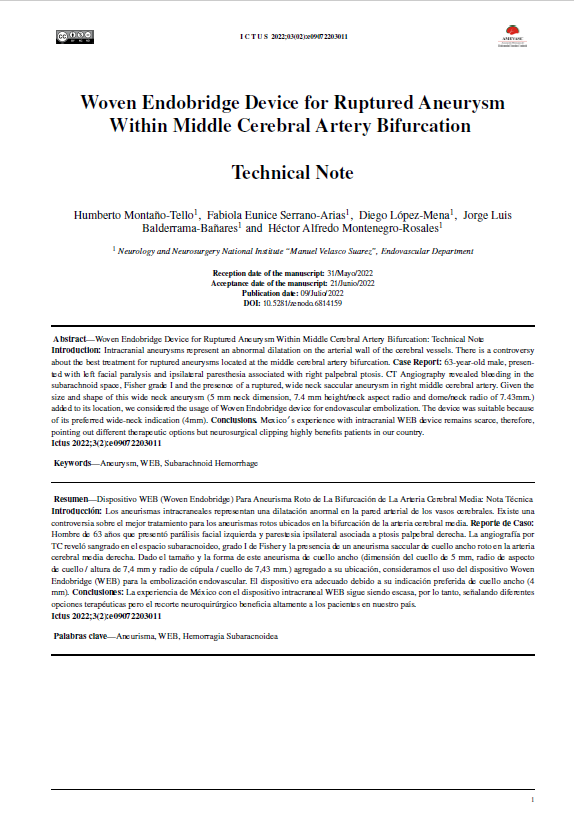Abstract
Introduction: Intracranial aneurysms represent an abnormal dilatation on the arterial wall of the cerebral vessels. There is a controversy about the best treatment for ruptured aneurysms located at the middle cerebral artery bifurcation. Case Report: 63-year-old male, presented with left facial paralysis and ipsilateral paresthesia associated with right palpebral ptosis. CT Angiography revealed bleeding in the subarachnoid space, Fisher grade I and the presence of a ruptured, wide neck saccular aneurysm in right middle cerebral artery. Given the size and shape of this wide neck aneurysm (5 mm neck dimension, 7.4 mm height/neck aspect radio and dome/neck radio of 7.43mm.) added to its location, we considered the usage of Woven Endobridge device for endovascular embolization. The device was suitable because of its preferred wide-neck indication (mayor/igual 4mm). Conclusions. Mexico´s experience with intracranial WEB device remains scarce, therefore, pointing out different therapeutic options but neurosurgical clipping highly benefits patients in our country.
References
Toth G, Cerejo R. Intracranial aneurysms: Review of current science and management. Vasc Med [Internet]. 2018;23(3):276–88. Disponible en: http://dx.doi.org/10.1177/1358863X18754693
Pierot L, Spelle L, Cognard C, Szikora I. Wide neck bifurcation aneurysms: what is the optimal endovascular treatment? J Neurointerv Surg [Internet]. 2021 [citado el 27 de abril de 2022];13(5):e9. Disponible en: https://jnis.bmj.com/content/13/5/e9
Procedural complications of endovascular treatment in patients with aneurysmal subarachnoid haemorrhage treated at a single centre. Alanen M, Pyysalo L, Jalava I, et al. Acta Neurochir, 2018;160:551–557. [PubMed] [Google Scholar]
Caroff J, Neki H, Mihalea C, D’Argento F, Abdel Khalek H, Ikka L, et al. Flow-diverter stents for the treatment of saccular middle cerebral artery bifurcation aneurysms. AJNR Am J Neuroradiol [Internet]. 2016;37(2):279–84. Disponible en: http://dx.doi.org/10.3174/ajnr.A4540
De Leacy RA, Fargen KM, Mascitelli JR, et al. Wide-neck bifurcation aneurysms of the middle cerebral artery and basilar apex treated by endovascular techniques: a multicentre, core lab adjudicated study evaluating safety and durability of occlusion (BRANCH). J Neurointerv Surg 2019;11:31–6.
Muskens IS, Senders JT, Dasenbrock HH, et al. The Woven Endobridge device for treatment of intracranial aneurysms: a systematic review. World Neurosurg 2017;98:809–17.
Arthur AS, Molyneux A, Coon AL, Saatci I, Szikora I, Baltacioglu F, et al. The safety and effectiveness of the Woven EndoBridge (WEB) system for the treatment of wide-necked bifurcation aneurysms: final 12-month results of the pivotal WEB Intrasaccular Therapy (WEB-IT) Study. J Neurointerv Surg [Internet]. 2019 [citado el 24 de marzo de 2022];11(9):924–30. Disponible en: https://jnis.bmj.com/content/11/9/924
Karhunen V, Bakker MK, Ruigrok YM, Gill D, Larsson SC. Modifiable risk factors for intracranial aneurysm and aneurysmal subarachnoid hemorrhage: A Mendelian randomization study. J Am Heart Assoc [Internet]. 2021;10(22):e022277. Disponible en: https://www.diva-portal.org/smash/get/diva2:1617103/FULLTEXT01.pdf
Saavedra CR, Rangel CC, Pichardo Uribe OA, Benavides OC, Orijel AP. Reconstrucción endovascular de aneurisma intracraneal mediante dispositivo diversor de flujo Pipeline® Reporte de 2 casos y revisión de la literatura. Rev Fac Med UNAM [Internet]. 2019 [citado el 24 de marzo de 2022];62(3):20–6. Disponible en: https://www.medigraphic.com/cgi-bin/new/resumen.cgi?IDARTICULO=86939
Zhang X, Tang H, Huang Q, Hong B, Xu Y, Liu J. Total hospital costs and length of stay of endovascular coiling versus neurosurgical clipping for unruptured intracranial aneurysms: Systematic review and meta-analysis. World Neurosurg [Internet]. 2018;115:393–9. Disponible en: http://dx.doi.org/10.1016/j.wneu.2018.04.028
Popielski J, Berlis A, Weber W, Fischer S. Two-center experience in the endovascular treatment of ruptured and unruptured intracranial aneurysms using the WEB device: A retrospective analysis. AJNR Am J Neuroradiol [Internet]. 2018;39(1):111–7. Disponible en: http://dx.doi.org/10.3174/ajnr.a5413
Asnafi S, Rouchaud A, Pierot L, Brinjikji W, Murad MH, Kallmes DF. Efficacy and safety of the Woven EndoBridge (WEB) device for the treatment of intracranial aneurysms: A systematic review and meta-analysis. AJNR Am J Neuroradiol [Internet]. 2016;37(12):2287–92. Disponible en: http://dx.doi.org/10.3174/ajnr.A4900
Pierot L, Cognard C, Anxionnat R, Ricolfi F, CLARITY Investigators. Endovascular treatment of ruptured intracranial aneurysms: factors affecting midterm quality anatomic results: analysis in a prospective, multicenter series of patients (CLARITY). AJNR Am J Neuroradiol [Internet]. 2012;33(8):1475–80. Disponible en: http://dx.doi.org/10.3174/ajnr.A3003
Goyal N, Hoit D, DiNitto J, Elijovich L, Fiorella D, Pierot L, et al. How to WEB: a practical review of methodology for the use of the Woven EndoBridge. J Neurointerv Surg [Internet]. 2020 [citado el 25 de marzo de 2022];12(5):512–20. Disponible en: https://jnis.bmj.com/content/12/5/512

This work is licensed under a Creative Commons Attribution 4.0 International License.
Copyright (c) 2022 Ictus

